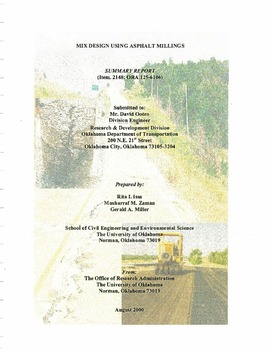| dc.description.abstract | A field demonstration project was undertaken by the Research & Development Division, Oklahoma Department of Transportation (ODOT), to investigate the performance of an asphalt overlay constructed using recycled asphalt millings and the cold-mixed, cold-laid-system. The project was pursued in cooperation with KOCH Materials in Wichita, Kansas, and the University of Oklahoma. A 1.9-km (1.2-mile) section of the US-64 North frontage road in Pawnee County was rehabilitated with a 5-cm (2-in) thick overlay using 100% recycled asphalt millings. The 1.9-km (1.2-mile) section was divided into four approximately equal test sections. A different type of emulsion was used to rejuvenate the asphalt millings for each test section. The pUipose was t-0 determine the relative performance of each emulsion type and construction method used in this recycled asphalt pavement (RAP) project. A laboratory investigation was carried out to accomplish two major tasks: the first task was to determine the optimum emulsion and moisture contents of RAP mixes prepared with four different types of emulsions; the second task was to investigate the effect of adding Portland cement to RAP mixes, producing a cement-emulsion composite. One of the objectives of this study was to document the behavior of RAP mixes as affected by the addition of Portland cement, and to find the optimum emulsion and cement contents. Achieving an adequate compaction is crucial to the successful performance of a cold-mixed, cold-laid overlay. The degree of compaction can greatly vary depending upon rolling pattern, speed, equipment, compaction dynamics, and characteristics of RAP mixes. From post-construction site visits, it was evident that the polymer modified anionic (PMA) emulsion section performed better than the other sections. This was consistent with the results of the laboratory investigation. A PMA mix containing 2% free moisture and 2% emulsion was found to be the optimum RAP mix. For samples prepared from cementemulsion composite, both dry and soaked stability values increased as cement content increased. The addition of Portlandˆ cement, however, affected the stability value of samples cured under soaked conditions much more than those cured under dry i conditions. The introduction of as little as 1 % of Portland cement to RAP mixes doubled the retained stability of specimens, as com.pared with a RAP mix rejuvenated with HFE-300 emulsion. The cold-mixed, cold-laid process of pavement rehabilitation holds significant promises for the future. The current: technology, however, needs improvement and refinement through further laboratory and field studies. | |
